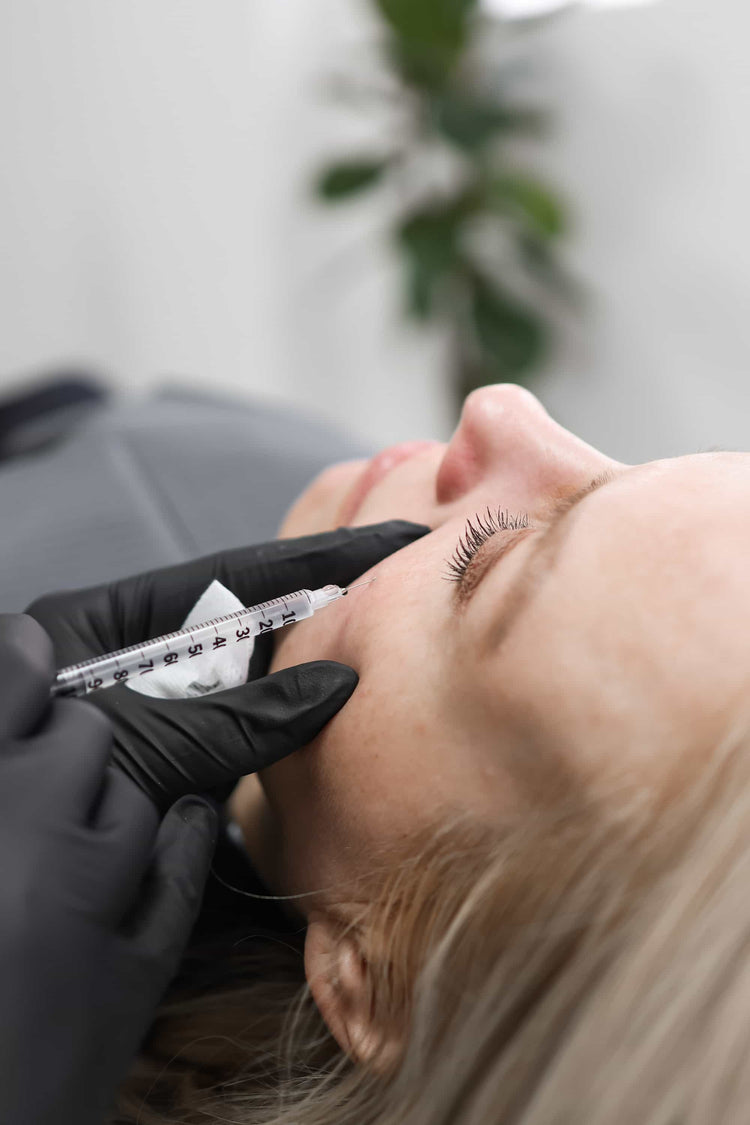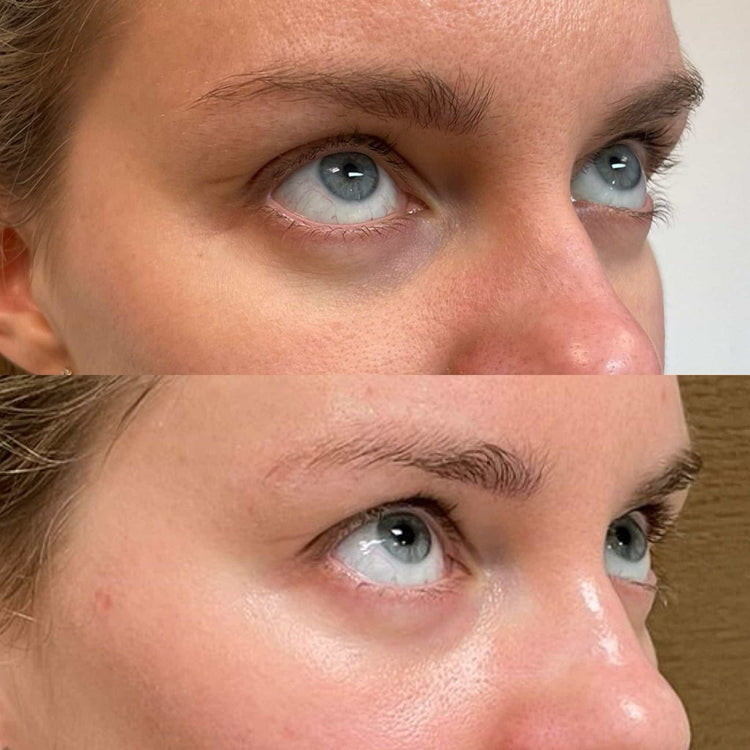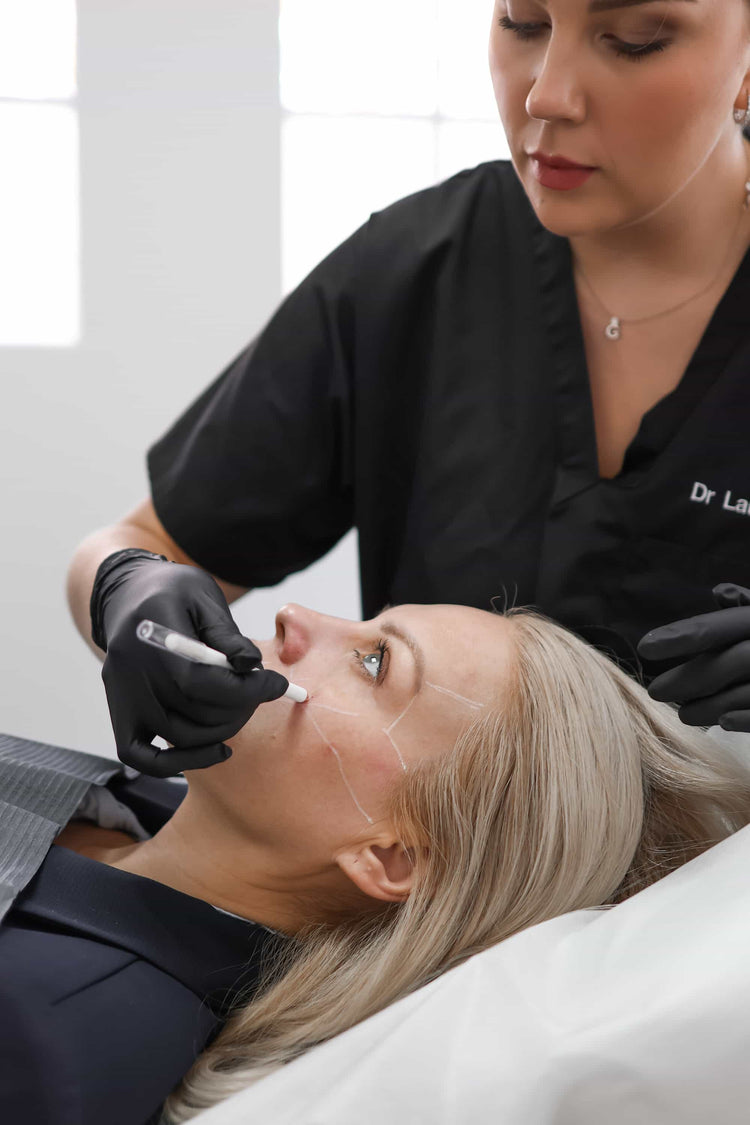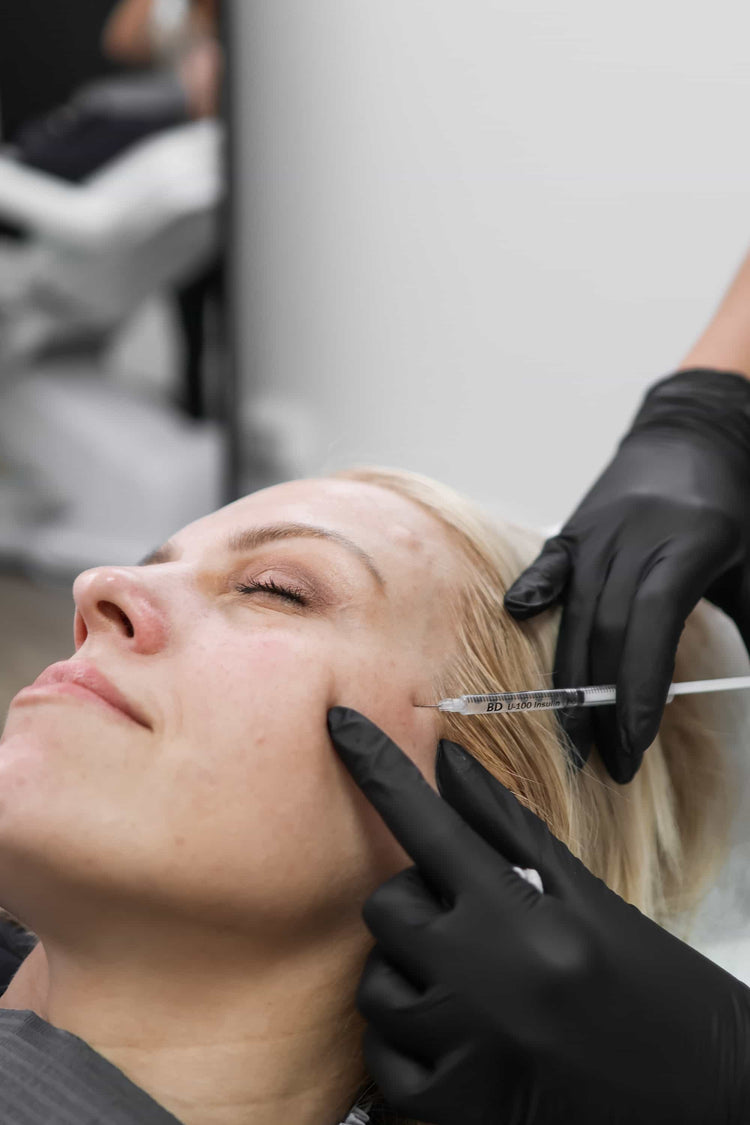Types of Dermal Fillers
Dermal fillers have become increasingly popular in Modern, Surrey for their ability to restore volume, smooth wrinkles, and enhance facial contours. These injectable gels are composed of various substances, each with unique properties and applications.
Hyaluronic Acid Fillers
One of the most common types of dermal fillers is hyaluronic acid (HA). HA is a naturally occurring substance in the body that helps to maintain skin hydration and elasticity. Hyaluronic acid fillers are particularly versatile, as they can be used to address a wide range of concerns, including nasolabial folds (laugh lines), marionette lines, volume loss in the cheeks or temples, and thin lips.
Poly-L-Lactic Acid (PLLA) Fillers
Poly-L-lactic acid (PLLA) fillers offer a long-lasting solution for facial rejuvenation. Unlike HA fillers that are instantly volumizing, PLLA gradually stimulates collagen production over time. This results in a gradual enhancement of facial contours and a more youthful appearance.
PLLA fillers are often preferred by individuals seeking subtle yet noticeable improvements. They are particularly suitable for addressing deeper wrinkles, restoring volume to sunken cheeks, and defining jawlines. The long-lasting effects of PLLA can last for several years, making it a worthwhile investment in maintaining youthful facial aesthetics.
Calcium Hydroxylapatite Fillers
Calcium hydroxylapatite fillers are another popular option for dermal rejuvenation. These fillers consist of microscopic calcium crystals suspended in a gel carrier. Calcium hydroxylapatite is a naturally occurring substance found in bones and teeth, providing a biocompatible and biodegradable material for facial enhancement.
This type of filler is particularly effective for addressing deeper wrinkles and folds, as its thicker consistency provides significant structural support. Calcium hydroxylapatite fillers can also be used to enhance cheekbones, redefine jawlines, and restore volume to the temples.
Benefits of Dermal Fillers
Dermal fillers have become increasingly popular in Modern, Surrey, offering a non-surgical way to enhance facial features and address signs of aging. These injectable gels are formulated with various substances, each designed to achieve specific aesthetic goals.
Reduces the Appearance of Wrinkles and Fine Lines

One of the most notable benefits of dermal fillers is their ability to dramatically reduce the appearance of wrinkles and fine lines. As we age, our skin naturally loses volume and collagen production slows down, leading to the formation of these creases and folds. Dermal fillers can effectively plump up the skin, filling in these depressions and smoothing out the wrinkles, giving the face a more youthful and refreshed appearance.
Enhances Facial Volume and Contour
Dermal fillers are renowned for their ability to enhance facial volume and contour, restoring a youthful and sculpted appearance.
By strategically injecting these gels into specific areas of the face, practitioners can add fullness to cheeks, temples, lips, and other regions that may have lost volume over time due to aging or natural facial changes.
This augmentation effectively creates a more defined and contoured look, enhancing facial symmetry and highlighting natural features.
Improves Lip Shape and Size
One of the most significant benefits of dermal fillers is their ability to dramatically improve lip shape and size. Hyaluronic acid fillers are particularly popular for this purpose as they can be precisely injected into the lips to add volume, enhance definition, and create a fuller, more symmetrical appearance.
Fillers can also help correct asymmetry in the lips, giving them a more balanced and aesthetically pleasing look. Whether someone desires subtle enhancement or a more dramatic transformation, dermal fillers offer a customizable solution for achieving the desired lip shape and size.

Restores Skin Elasticity
Dermal fillers play a crucial role in restoring skin elasticity by stimulating collagen production. As we age, our bodies produce less collagen, leading to thinner, less elastic skin. Fillers like poly-L-lactic acid (PLLA) work by prompting the body’s natural collagen synthesis, gradually plumping up the skin and improving its resilience.
Procedure for Dermal Filler Treatment
Dermal fillers are a popular choice in Modern, Surrey for addressing signs of aging and enhancing facial features. These injectable gels contain various substances designed to target specific aesthetic concerns.
Consultation and Assessment
The procedure for dermal filler treatment typically begins with a thorough consultation and assessment. During this appointment, a qualified practitioner will discuss your desired outcome, medical history, and any potential allergies or contraindications. A detailed examination of your facial features will be conducted to determine the appropriate type and amount of filler required.
Prior to the procedure, the treatment area will be cleansed and disinfected. Topical anesthetic may be applied to minimize discomfort. The chosen dermal filler will then be injected into specific areas using fine needles or cannulas. The practitioner will carefully inject the filler in precise amounts and locations to achieve the desired aesthetic effect.
After the injections, gentle massage may be performed to distribute the filler evenly and minimize bruising. Ice packs may also be applied to reduce swelling. Most patients can resume their normal activities immediately following treatment, although it is recommended to avoid strenuous exercise or facial massage for a few days.
The results of dermal filler treatment are typically visible immediately after the procedure, although some swelling and bruising may subside over the next few days. The longevity of the results varies depending on the type of filler used and individual factors. Hyaluronic acid fillers generally last 6 to 18 months, while PLLA fillers can provide long-lasting results for several years.
Treatment Process
The procedure for dermal filler treatment typically begins with a thorough consultation and assessment. During this appointment, a qualified practitioner will discuss your desired outcome, medical history, and any potential allergies or contraindications. A detailed examination of your facial features will be conducted to determine the appropriate type and amount of filler required.
Prior to the procedure, the treatment area will be cleansed and disinfected. Topical anesthetic may be applied to minimize discomfort. The chosen dermal filler will then be injected into specific areas using fine needles or cannulas. The practitioner will carefully inject the filler in precise amounts and locations to achieve the desired aesthetic effect.
After the injections, gentle massage may be performed to distribute the filler evenly and minimize bruising. Ice packs may also be applied to reduce swelling. Most patients can resume their normal activities immediately following treatment, although it is recommended to avoid strenuous exercise or facial massage for a few days.
The results of dermal filler treatment are typically visible immediately after the procedure, although some swelling and bruising may subside over the next few days. The longevity of the results varies depending on the type of filler used and individual factors. Hyaluronic acid fillers generally last 6 to 18 months, while PLLA fillers can provide long-lasting results for several years.
Aftercare Instructions
Following your dermal filler treatment, it’s essential to follow these aftercare instructions to ensure optimal healing and results:
Avoid touching or massaging the treated area for at least 24 hours.
Do not apply makeup or any other skincare products to the injection sites for the first 24 hours.
It’s normal to experience some mild swelling, redness, and bruising after the procedure. Applying ice packs for 15-20 minutes at a time can help reduce these side effects.
Stay hydrated by drinking plenty of water to promote healing.
Avoid strenuous exercise or activities that may cause sweating for the first 48 hours.
Sleep with your head slightly elevated to minimize swelling.
Refrain from consuming alcohol and smoking as they can interfere with the healing process.
Attend any follow-up appointments scheduled by your practitioner to ensure proper healing and address any concerns.
If you experience any unusual symptoms, such as severe pain, infection, or asymmetry, contact your practitioner immediately.
Cost of Dermal Fillers in Modern, Surrey
The cost of dermal fillers in Modern, Surrey can vary depending on several factors, including the type and amount of filler used, the area being treated, and the experience of the practitioner.
Factors Affecting Price
On average, you can expect to pay between £250 and £600 per syringe of dermal filler in Modern, Surrey.
The price can be influenced by the specific type of filler chosen, as some fillers are more expensive than others due to their unique properties or ingredients. For example, hyaluronic acid fillers are generally less expensive than PLLA or calcium hydroxylapatite fillers.
The size of the treatment area also plays a role in determining the cost. Larger areas, such as the cheeks or jawline, will typically require more filler, resulting in a higher price.
The experience and reputation of the practitioner administering the treatment can also affect the cost. Highly experienced and sought-after practitioners may charge higher fees due to their expertise and demand.
Average Cost Range

The cost of dermal fillers in Modern, Surrey can vary depending on several factors, including the type and amount of filler used, the area being treated, and the experience of the practitioner.
On average, you can expect to pay between £250 and £600 per syringe of dermal filler in Modern, Surrey.
Choosing a Reputable Clinic in Modern, Surrey
Choosing a reputable clinic is crucial when considering dermal fillers in Modern, Surrey.

Qualifications and Experience of Practitioners
Look for clinics with experienced and qualified practitioners who are registered with relevant professional bodies.
- Check the clinic’s website or online reviews for testimonials from previous patients.
- Inquire about the practitioner’s experience and qualifications in performing dermal filler treatments.
- Ensure that the clinic uses high-quality, FDA-approved fillers from reputable manufacturers.
- Ask about the clinic’s sterilization practices and infection control measures.
- Consult with multiple clinics to compare pricing, services, and practitioner expertise.
Client Reviews and Testimonials
Choosing a reputable clinic is crucial when considering dermal fillers in Modern, Surrey. Look for clinics with experienced and qualified practitioners who are registered with relevant professional bodies. Check the clinic’s website or online reviews for testimonials from previous patients. Inquire about the practitioner’s experience and qualifications in performing dermal filler treatments. Ensure that the clinic uses high-quality, FDA-approved fillers from reputable manufacturers. Ask about the clinic’s sterilization practices and infection control measures. Consult with multiple clinics to compare pricing, services, and practitioner expertise.
Safety Measures and Protocols
Choosing a reputable clinic is paramount when considering dermal fillers in Modern, Surrey. Look for clinics that prioritize patient safety and well-being by adhering to strict safety measures and protocols.
Reputable clinics will have qualified practitioners who are registered with relevant professional bodies, demonstrating their expertise and commitment to ethical practice.
Inquire about the clinic’s sterilization practices to ensure they use sterile equipment and follow proper disinfection procedures to minimize the risk of infection.
A reputable clinic will also emphasize patient consultation and personalized treatment plans. During your consultation, the practitioner should thoroughly discuss your medical history, desired outcomes, and any potential risks or side effects associated with dermal fillers.
They will assess your skin type and facial features to determine the appropriate type and amount of filler needed to achieve your desired results safely and effectively.
Furthermore, a reputable clinic should use high-quality, FDA-approved fillers from trusted manufacturers. Inquire about the specific brands they use and ensure they are up-to-date on the latest research and advancements in dermal filler technology.
Potential Risks and Side Effects
While dermal fillers can provide noticeable aesthetic improvements, it’s essential to be aware of potential risks and side effects. These may include temporary swelling, redness, bruising, itching, tenderness, and discomfort at the injection site. In rare cases, more serious complications like infection, allergic reactions, or vascular occlusion (blockage of blood vessels) can occur.
Bruising and Swelling
Potential risks and side effects associated with dermal fillers include:
- Bruising and swelling: These are common side effects that usually resolve within a few days. Applying ice packs and avoiding strenuous activity can help minimize these effects.
- Redness and tenderness: The treated area may be red and tender for a short period, but this typically subsides quickly.
- Itching and discomfort: Some patients may experience mild itching or discomfort at the injection sites, which usually resolves on its own.
- Lumps and bumps: In rare cases, filler can form lumps or bumps under the skin, which may need to be massaged or dissolved by a practitioner.
- Infection: As with any medical procedure, there is a risk of infection. It is important to follow proper aftercare instructions and consult your practitioner if you notice any signs of infection, such as redness, swelling, pain, or pus.
It’s crucial to have dermal fillers administered by a qualified and experienced practitioner in a sterile environment to minimize the risk of complications.
Infection
While dermal fillers can provide noticeable aesthetic improvements, it’s essential to be aware of potential risks and side effects. These may include temporary swelling, redness, bruising, itching, tenderness, and discomfort at the injection site. In rare cases, more serious complications like infection, allergic reactions, or vascular occlusion (blockage of blood vessels) can occur.
Potential risks and side effects associated with dermal fillers include:

- Infection: As with any medical procedure, there is a risk of infection. It’s important to follow proper aftercare instructions and consult your practitioner if you notice any signs of infection.
- Allergic reactions: Although rare, some individuals may experience allergic reactions to the ingredients in dermal fillers. These reactions can range from mild itching or redness to more severe symptoms like swelling, hives, or difficulty breathing. If you have a history of allergies, be sure to inform your practitioner beforehand.
- Vascular occlusion: This serious complication occurs when a filler is injected into a blood vessel, blocking the flow of blood. It can lead to tissue damage and require prompt medical attention.
It’s crucial to have dermal fillers administered by a qualified and experienced practitioner in a sterile environment to minimize the risk of complications.
Lumps or Nodules
Potential risks and side effects associated with dermal fillers include bruising, swelling, redness, tenderness, itching, and discomfort at the injection site. These are usually temporary and resolve within a few days.
In rare cases, more serious complications can occur such as infection, allergic reactions, or vascular occlusion (blockage of blood vessels). It’s important to have dermal fillers administered by a qualified and experienced practitioner in a sterile environment to minimize the risk of these complications.

Lumps or nodules may also form under the skin, which may need to be massaged or dissolved by a practitioner. Always follow your practitioner’s aftercare instructions carefully to promote healing and reduce the risk of side effects.
Allergic Reactions
Potential risks and side effects associated with dermal fillers include temporary swelling, redness, bruising, itching, tenderness, and discomfort at the injection site. In rare cases, more serious complications like infection, allergic reactions, or vascular occlusion (blockage of blood vessels) can occur.
It’s important to consult with a qualified and experienced practitioner in a sterile environment to minimize these risks. Allergic reactions, although uncommon, can range from mild itching or redness to more severe symptoms such as swelling, hives, or difficulty breathing. It’s crucial to inform your practitioner of any allergies you have before undergoing treatment.
Find your best lip filler solution with Dr. Laura Geige at It’s Me & You Clinic
- Filler For Flat Cheeks In Upper Halliford, Surrey - September 25, 2025
- Downturned Smile Treatment Near Little Bookham, Surrey - September 22, 2025
- Dermal Fillers In Morden, Surrey - September 21, 2025
